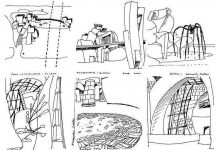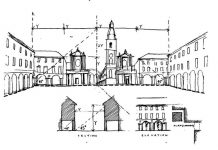The Italian movement known there as la Tendenza explored a way of building that was at once new and responsive to the shapes, forms and city plans of the past. Offering a voice of reason in opposition to the loud cries of modernism and postmodernism, it has become known outside Italy as neorationalism.
Many of the great architectural ideas of the late 20th century represent architects finding ways of moving beyond the modernism that had dominated architecture from the 1920s to the 1960s. Postmodernism, with its playfulness, its glorification of the commercial culture of Las Vegas, its off-hand historical references, was one route. But for some it was too brash, too consumerist. And brash consumerism, whether in the form of poorly detailed skyscrapers, glitzy cinemas or plastic shop fronts, was certainly taking over many a town center.
The city and memory
Against this background a number of architects, especially in Italy, began to look differently at cities and urban forms. Rather than aspiring to create brand-new ideal cities from scratch, as the modernists had done, architects and planners looked at old cities as places of interest from which they could learn. Cities are repositories of memory and hold important lessons about how society has evolved. Studying a city—how its buildings, plots, blocks, streets, squares and overall plan have changed through time—can tell us much about the past and help illuminate the present.
Italian architects, theorists and historians responded well to these types of ideas about the history and form of the city. Their work bore fruit in a range of activities, from building-restoration projects to books, such as urban historian Leonardo Benevolo’s huge and stimulating The History of the City. Aldo Rossi, the founder of the neorationalist movement, was also a writer, and his 1966 book, The Architecture of the City, also addressed these issues.
New and old
The neorationalists worked against this background of historical awareness, of studying the shape or morphology of the city and of responding to current needs in the light of past heritage. So they were keen to build sensitively, but imaginatively in the great cities of Europe—and to avoid their domination by modernism, by the brash values of consumerist society or by the often crass designs of the communist countries of eastern Europe. They wanted to build new buildings, but structures that showed an awareness of and sensitivity to the past.
The movement emerged most strongly in Italy, where architects had the opportunity to learn from stunning historical cities. Rossi was also stimulated by the paintings of Giorgio de Chirico, haunting, surreal canvases in which strong, raking light plays on the details of quiet city squares and streets, picking out arcades, towers, monuments and statues. Rossi’s work, exemplified by his cemetery buildings in Modena, evokes a similar atmosphere, with arch-lined “streets,” a pale red-walled ossuary with a pattern of square openings in the wall and quiet, open spaces.
From building to product
The classical geometry of neorationalist buildings can be applied to much smaller forms than those of buildings, and some architects of the movement have also worked in product design. Aldo Rossi, for example, produced several designs for Alessi, including a striking stockpot called La Cupola (below right). It is based on a simple, shiny, metal cylinder topped by a hemispherical, dome-like lid. Mario Botta’s pitcher (below left), also designed for Alessi, is likewise based on a cylinder, but with its top sliced off at a steep angle, rather like the roof of one of his buildings.

There is something in the pure forms and monumental quality of these buildings that recalls the vast unbuilt projects of those great French masters of the 18th-century age of reason, Boullée and Ledoux (see Reason). The French architects’ big abstract forms— Boullée’s plan to build a spherical monument to Isaac Newton 152 meters (500 ft) in diameter, for example—have a similar quality and this is revealed in the respective architects’ drawings. Rossi’s aerial perspective of the cemetery project shows the buildings casting long, dark shadows that recall Boullée’s work.
Neorationalism began in Italy, spearheaded by Rossi’s writings and by a book by another Italian architect, Giorgio Grassi, La costruzione logica dell’architettura. It bore fruit in works such as Rossi’s housing scheme in the Gallaratese district of Milan and his reconstruction of the damaged Teatro Carlo Felice in Genoa.
“The Tendenza was clearly an attempt to save both architecture and the city from being overrun by the all-pervasive forces of megalopolitan consumerism.” Kenneth Frampton, Modern Architecture: A Critical History
Beyond Italy
But many buildings influenced by the movement have been created outside Italy, making similar play with archetypal shapes and strange, tantalizing openings, as if conjuring up the ghosts of past buildings, but also suggesting that there is something interesting and different inside.
Some of the buildings of the Portuguese architect Álvaro Siza work in this way—his Galician Center for Contemporary Art at Santiago de Compostela, for example, a huge, apparently simple form with dramatic horizontal “slices” cut out of it that seem to invite the visitor inside.
One of the most successful architects influenced by these ideas is Mario Botta, the Swiss designer of a wide range of buildings characterized by strong and evocative forms. In France H.E. Ciriani showed the influence of neorationalism in a housing complex at Marne-la-Vallée near Paris. And in Germany Mathias Ungers and J.P. Kleihues have worked in a similar way to the Italian neorationalists, setting sensitive new buildings in historic town centers.
Many cities in western Europe have benefited from these architects’ sensitive approach to urban design and form, reminding us that new buildings can sit comfortably beside old ones, while adding something fresh to the ever-changing urban mix.



















